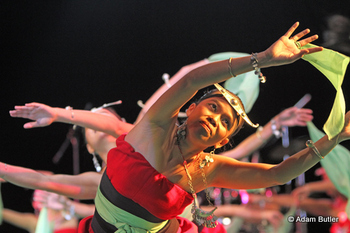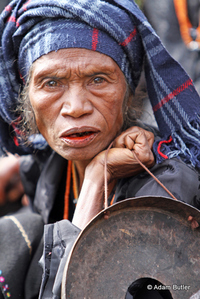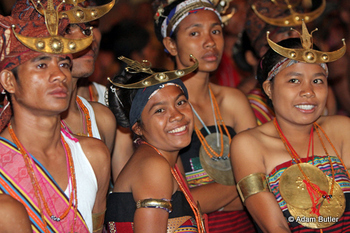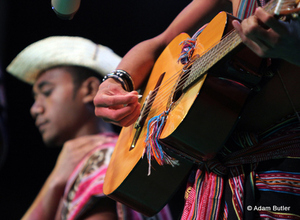By Louisa Butler

Ethnic Timorese attire is complete from intricate headgear to ankle wrap.
Koh Lanta, 15 November 2010. Timor-Leste (or East Timor) is a small new nation with a big character. Colonised by the Portuguese in the 1500s, controlled by the Japanese during World War II, made independent by Lisbon after the coup in Portugal in 1974, seized by the Indonesians in 1975 and finally shaking free in 2002, the identity of East Timor has strong foundations in its survival against its history of occupation and hardship.
Mount Ramelau is Timor-Leste’s highest mountain; the peak sits at 2963m and from the top you can have a panoramic view of all 13 districts of the country. For the Timorese people it has a strong cultural significance as a symbol of unity, pride and heroism, making it a perfect backdrop to the Ramelau Festival of Music and Culture, the first of its kind in the history of Timor-Leste.
The festival is part of President José Ramos-Horta’s initiative to promote peace and unity in the world’s newest nation. The Dili City of Peace Initiative comprises the Tour de Timor, International Marathon Race, the Darwin to Dili Yacht Race and an Underwater Photography Contest, with the aim of raising Timor-Leste’s profile as an important eco-tourism destination.
At the base of Mount Ramelau sits Hatu Builico, a village made up of a small community of Timorese living mostly on subsistence farming. Occasionally wanderlust tourists stir some excitement as they trudge up the highlands. It was here in Hatu Builico that the 13 tribes of Timor-Leste were to come together and perform their traditional and modern music and dance.
The Ramelau Festival was organised and managed entirely by Timorese with no outside help. It was there that the vision, scope and ambition of this new country was showcased - a huge stage, an enormous sound and lighting system and an exciting program for the festival.

Fabrics, waves and music convey expressions of happiness and freedom.
Before the festival swung into action, there were some fascinating activities. First, a traditional ceremony with the local tribe formally handing over the power of the district to the President as a mark of respect. Then, a formal opening of the newly constructed stairway up to the peak. Next a different kind of competition an average Timorese would give an arm and a leg for - a race up and down the great mountain slopes!
Some two and half kilometres up the small mountain track from Hatu Builico is a beautiful meadow that sits in the shadow of Mount Ramelau. This has been the starting point for hiking up to the peak of the mountain, also where the new stairs up to the summit start. You can also find an open air church with a Virgin Mary shrine at the base of the stairs. At the peak, a large statue of the revered lady gaze down at all.

President Horta assumes the role of tribal leader in Hatu Builico.
In this meadow, local tribesmen and women began their traditional dance accompanied by drums and cymbals to welcome President José Ramos Horta. They dressed him with their traditional costume and jewellery to complete the ceremony to hand over control of their lands to him. This is not a literal transfer of power, but a show of respect from the indigenous Timorese of the area.
It was fabulous to watch the ceremony - great care was taken to shroud and dress the President correctly. The President and heads of the districts were then given betel nuts wrapped in betel leaves to eat, before more chanting and dancing began to complete the ritual.
Ribbon cutting by the President signalled the inauguration of the stairs. Next up was the Hiking Competition, which was basically a race to the peak of Ramelau and back. The rewards were worth the sweat and muscle fatigue with a first prize of US$1000, second of US$700 and third of US$500. As the average yearly wage here is around US$700, there was a lot of excitement about this event! The winning hiker, or really a runner, did the round trip in only 67 minutes, covering a vertical distance of nearly 300 metres.
This event could very well be an annual affair, a nice add-on to the music festival proper.

Gongs and drums are mainstay Timorese traditional instruments.
Joel Pereira, an event organiser, told us that another reason for the event was to promote Hatu Builico and Mount Ramelau as a tourist destination for locals as well as visitors. For the music festival, Timorese came from all 13 districts; some travelled from Oecusse, the East Timor enclave in Indonesian West Timor well over 100 miles away.
All the districts were introduced on the first evening; each wore traditional dress with slight distinction depending on their tribal origin. The pride they had in their culture was evident, shining through the intricate costumes worn.
Timorese women use simple looms to weave magnificent fabrics called ‘tais’ with bright colourful stripes. Symbols of the crocodile can be spotted on fabric too, an animal very important to the Timorese as legend has it that they descended from these large reptiles. Each district has their own way of fabric weaving; these are wrapped sarong style or tied around the body.
The traditional dances involved ensemble style movements, as well as symbolic ‘fight’ dances, where two men would perform a slow choreographed ‘fight’ while women thumped on small drums. Guitars and violins featured in traditional music alongside the more basic drums and cymbals. Some of the performers even sang choral style.

Youths are proud of their heritage too.
Between the traditional performances and well into the night, Timorese rock bands sizzled the atmosphere blasting at full volume and with huge lighting effects, to the evident enjoyment of the festival goers who despite the cold stayed up dancing, wrapped in blankets, late into the night.
It was almost 10 degrees Celsius up there in the night and we regretted not having our thermals with us. Yet down at Dili, the capital of the country, the climate was warmer at 28 degrees Celsius.
Braving the cold and winds, students from Dili-based dance club St Antonio Group performed modern interpretive dance with some stunning effects using fabric, lighting and music.
Each district performed a traditional dance with music, which were then judged by a panel on the various technical attributes. Although this festival had a competitive element where top performers clinched prizes, all districts received a reward for their participation.

Modern fusion with guitars and violins is commonplace in Timor-Leste.
Timor-Leste’s Ramelau Festival of Culture and Music is definitely not to be missed. It was fantastic to see the traditional Timorese music and dance, as well as the more westernised rock music. I was delighted to watch the enjoyment of the event on the faces of the simple Timorese folks who had travelled a long distance from their village across the country to Hatu Builico to be part of the festival.
President José Ramos-Horta had wanted the festival to be organised by, and for, the Timorese people, and I have to say that they did a fantastic job! As a foreigner I felt privileged to be there to witness the first of what I hope will be many festivals in the future. People who are interested in getting off the beaten track, enjoying beautiful countryside and experiencing a vibrant culture should definitely have this on their travel list!
Gaia Discovery thanks Air Timor, Timor Lodge, and the organisers of the festival for making this article possible.
Photography by Adam Butler.
Adam & Louisa Butler specialize in photography and videography. They live in Koh Lanta, Thailand and spend waking moments shooting tropical weddings, underwater activities, media related and advertising photographs/video.